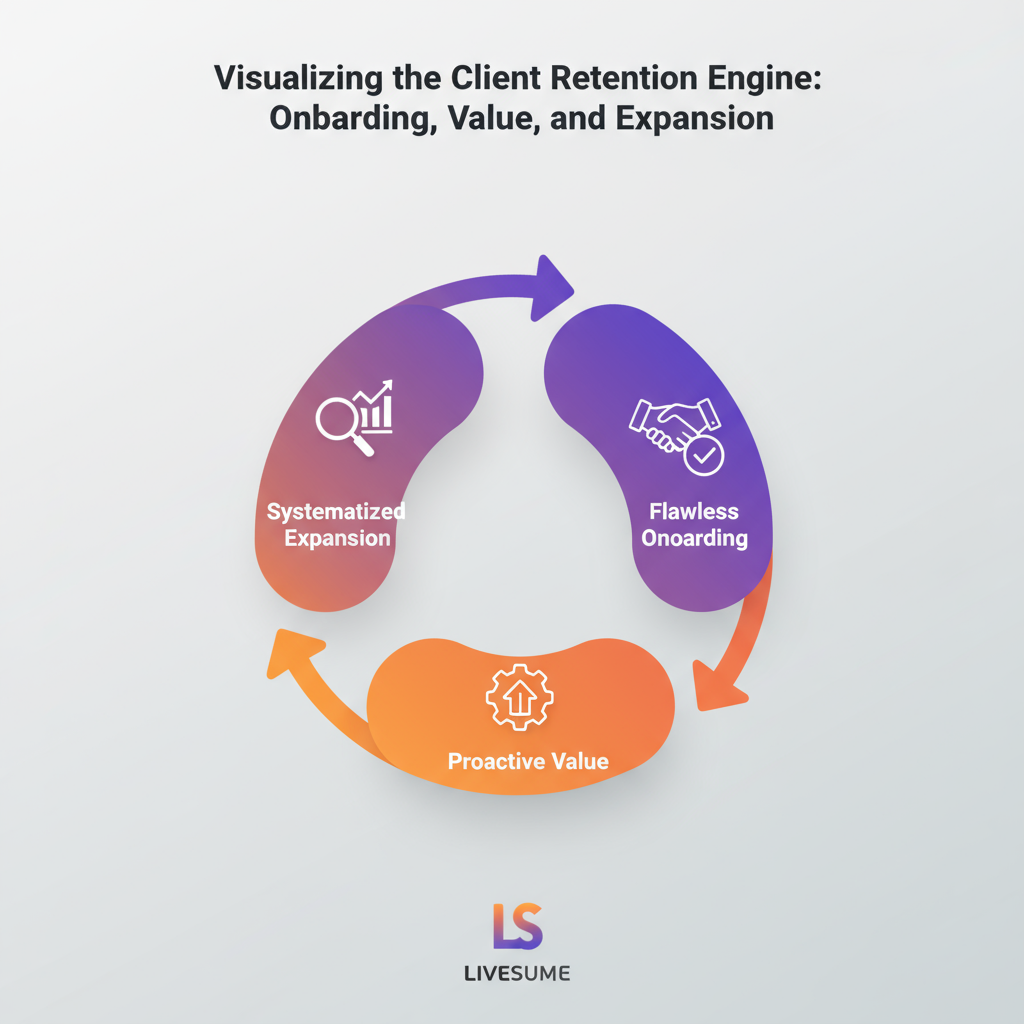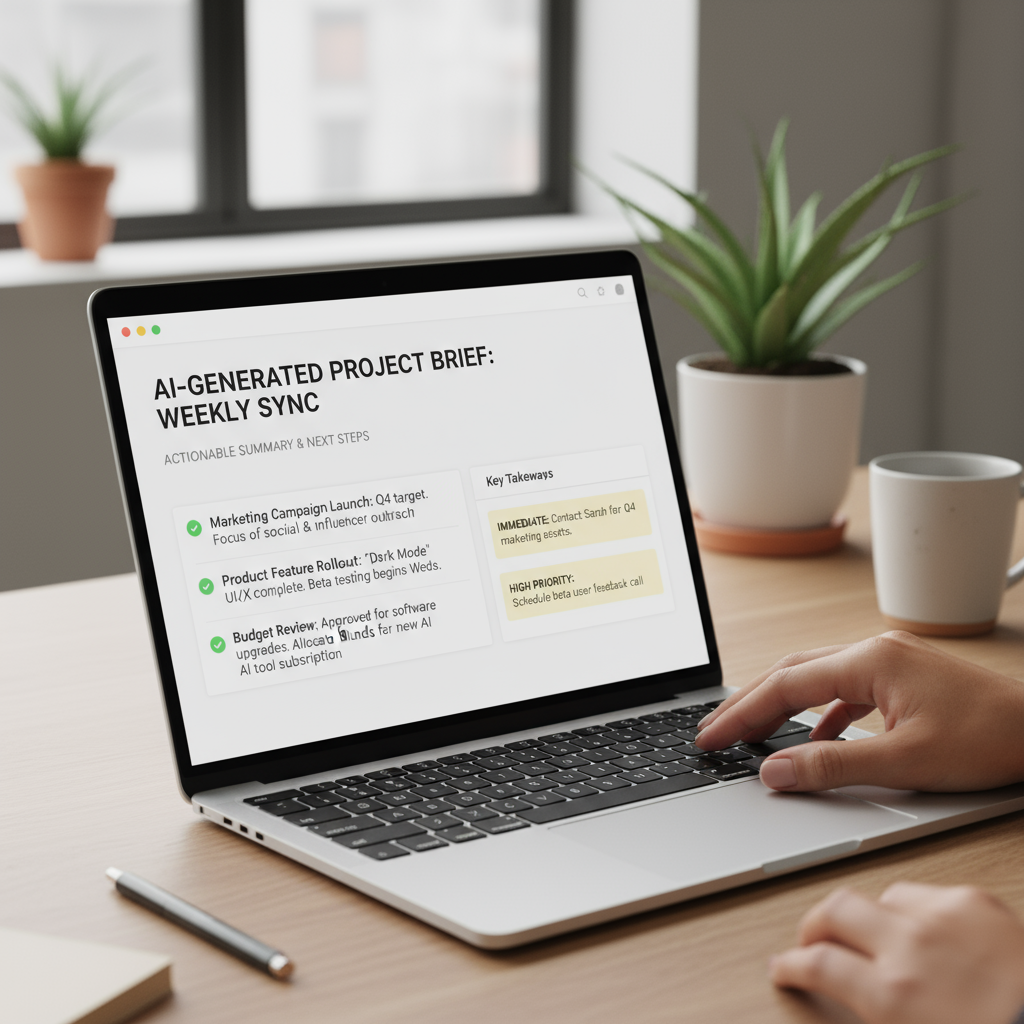Tired of the freelance feast-or-famine cycle? You land a great client, do amazing work, and then... silence. The project ends, and you're right back to hunting for new leads. This constant churn isn't just exhausting; it's a silent profit killer. What if you could build a system that not only keeps your best clients but turns them into a predictable source of recurring revenue? It's not about working harder; it's about using simple AI to work smarter.
Key Takeaways: Build Your Retention Engine
- Stop Guessing, Start Systematizing: Move from random "check-ins" to a repeatable, 3-part framework (Onboarding, Proactive Value, Expansion) that builds loyalty.
- Let AI Handle the Heavy Lifting: We’ll show you how specific AI tools can automate progress reports, analyze client sentiment in emails, and keep you organized—freeing you up for high-impact creative work.
- Identify Churn Risks Early: Learn to use simple sentiment analysis to spot an unhappy client before they decide to leave, giving you a chance to fix the relationship.
- Find Hidden Growth Opportunities: Your AI-powered system will help you identify the perfect moments to pitch new projects or ask for referrals, without feeling salesy.
- Create a Premium Client Experience: A well-oiled retention engine makes clients feel valued and understood, turning them into advocates for your business.
Why Your Freelance Business Leaks Money (and How to Fix It)
Most freelancers focus all their energy on acquisition. But acquiring a new client can be 5 to 25 times more expensive than retaining an existing one. When you don't have a system for retention, your business is like a leaky bucket—you're pouring new leads in the top while your best clients quietly slip out the bottom.
The old advice—"communicate well," "be nice"—is true, but it's not a strategy. It relies on manual effort and good intentions. A modern retention strategy uses technology to create a reliable process.
Before: You manually track client details in a spreadsheet (when you remember) and rely on your gut to know when to check in. You find out a client is unhappy only when they send the "we're parting ways" email.
After: An AI-powered CRM tracks every interaction. An AI assistant flags that a client's email tone has become less positive over the past month. You proactively schedule a call, address a hidden issue, and save the account. That's the power of a system.

Introducing the 3-Part Client Retention Engine
Instead of a random list of tips, let's build an engine. It’s a machine with three connected stages that work together to create consistently happy clients who stick around and spend more. The goal is to make a premium client experience your default setting.
- Stage 1: Flawless Onboarding: Make an incredible first impression that sets the foundation for a long-term partnership.
- Stage 2: Proactive Value: Deliver consistent value and maintain communication, anticipating needs before the client even has to ask.
- Stage 3: Systematized Expansion: Identify and act on opportunities for growth, turning one-off projects into recurring revenue streams.
Stage 1: Engineer a Flawless Onboarding Experience
Client retention doesn't start when the project is ending; it starts the moment they sign the contract. A sloppy, confusing onboarding process creates immediate doubt. A smooth, professional one builds instant confidence. Your goal here is to use AI to personalize the experience and automate the admin.
Use AI to Personalize, Not Just Process
Don't just treat them like another project number. Use a smart CRM to build a real profile. AI-powered CRMs like Folk or Attio can automatically pull in a client's LinkedIn activity, recent blog posts, or company news. This isn't for being creepy; it's for being thoughtful. You can reference a recent company milestone on your kickoff call or understand their professional context better.
Automate Kickoffs and Information Gathering
Stop the endless email chains trying to find a meeting time. Use a tool like Calendly, which can automatically schedule kickoff calls based on your availability. After the call, use an AI assistant like Notion AI to summarize your raw notes into a clean, actionable project brief that you can share with the client. This makes you look incredibly organized and efficient from day one.

Stage 2: Deliver Proactive Value (Before They Have to Ask)
This is where most freelancers drop the ball. The project gets busy, and communication becomes purely reactive. The retention engine, however, is designed to be proactive. It maintains momentum and demonstrates your value long before the final invoice is due. A key part of this is building your professional page as a central hub for client resources.
Audit Client Communications with Sentiment Analysis
How do you know if a client is quietly becoming unhappy? You listen to what they're not saying directly. Tools like MonkeyLearn can be trained to analyze the sentiment of client emails. You can connect it via Zapier to run a periodic check. If the tool detects a shift from positive to neutral or negative language, it can send you a private alert. This gives you a data-driven reason to check in and ask, "How are things really going?"
Automate Progress Updates and Check-ins
Clients hate being in the dark. Manually writing a weekly summary email can feel like a chore, so many freelancers skip it. This is a perfect job for AI. Project management tools like Asana AI or Notion AI can now generate instant progress reports based on completed tasks. Just review, edit for your personal touch, and send. It takes you 5 minutes instead of 30 and keeps the client feeling confident and informed.
Build a "Home Base" for Your Clients
Stop burying project files and meeting notes in endless email threads. Use your Livesume professional page to create a simple, dedicated client portal. It's the perfect hub for your client retention engine. Build your free client portal page today.
Stage 3: Systematize Expansion and Referrals
The easiest person to sell to is a happy customer. "Upselling" shouldn't be a dirty word. When you've done great work, expanding the relationship is the logical next step. But it shouldn't be random. For ideas on what to sell, check out our guide on how to stop selling hours and start selling outcomes.
Triage Opportunities with Your AI-Powered CRM
Configure your CRM to track key client goals. When you mark a primary project goal as "achieved," it can trigger a task for you to "Propose Phase 2" or "Discuss Retainer Options." This turns a successful project delivery into a systematic trigger for a new business conversation. You're not just asking for more work; you're logically continuing the value you've already created.
The Human Touch: Know When to Go Analog
AI is your assistant, not your replacement. For your top 10% of clients, the system should also include high-touch, human elements. After a huge project win, consider using a service like Alyce to send a small, personalized gift that reflects their interests (which you've conveniently stored in your CRM). This kind of memorable gesture is what separates a good freelancer from an indispensable partner.

Frequently Asked Questions (FAQ)
1. How do I increase my freelance client retention rate?
Move from reactive to proactive. Don't wait for clients to raise issues. Send regular progress updates, schedule check-ins before problems arise, and consistently show you're thinking about their success. Clients stay when they feel consistently supported.
2. How can I get more recurring work from existing clients?
Map their business goals beyond your current project. When you deliver Phase 1, have Phase 2 ready—position it as the natural next step to build on your shared success. Make continuation feel obvious, not like a hard sell.
3. What tools help manage freelance clients better?
Start with a CRM for relationship tracking and a project management tool for progress updates. The specific software matters less than having a system that automates communication and keeps nothing from falling through the cracks.
4. How do I know if a client is about to leave?
Watch for warning signs: suddenly going quiet, shorter or colder emails, questioning invoices they previously paid without comment, or delayed responses. When you spot these patterns, schedule a proactive check-in to address concerns before they become deal-breakers.
5. What's the difference between client retention and client satisfaction?
Satisfaction measures how clients feel about past work. Retention measures whether they choose to work with you again. High satisfaction doesn't guarantee retention—you also need proactive engagement and clear demonstrations of future value.
6. How often should I communicate with freelance clients?
Establish a predictable rhythm. Weekly progress emails work well for most projects. For larger engagements, add a bi-weekly 15-minute call. Consistency matters more than frequency—clients should never wonder what you're doing or whether you've forgotten them.
Turn Your Retention System Into a Growth Engine
Client relationships are your most valuable business asset. Don't leave them to chance. By implementing this 3-part engine, you're not just preventing churn; you're building a predictable, scalable foundation for your entire freelance business. The same principles that win clients are foundational to keeping them, which is why a strong client-closing landing page is just the beginning of the journey.
Here’s how to start today:
- Choose Your Core Tool: Pick one AI-powered CRM to be your single source of truth for all client information.
- Map Your Onboarding: Document your current onboarding process and identify one step you can automate this week (e.g., using Calendly for scheduling).
- Set Up One Proactive Alert: Create a single automated weekly progress report for your most important client.
Start small, build momentum, and turn your hard-won clients into your biggest fans.